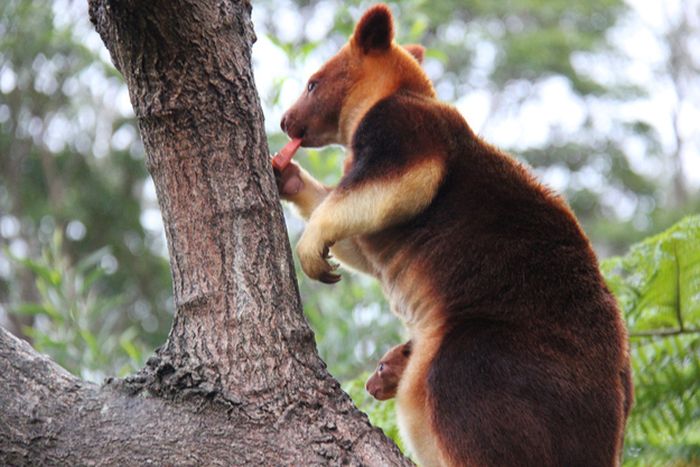|
|
Baby Tree Kangaroo Joey, Taronga Zoo, Sydney, New South Wales, Australia
|
The evolutionary history of tree-kangaroos begins with a rainforest floor dwelling pademelon-like ancestor (Thylogale spp.). This ancestor evolved from an arboreal possum-like ancestor as is suspected of all macropodid marsupials in Australia and New Guinea. During the late Eocene the Australian/New Guinean continent began a period of drying that caused a retreat in the area of rainforest. The retreat of the rainforest forced the ancestral pademelons to begin living in a dryer, rockier environment. After some generations of adaptation to the new environment, the pademelons evolved into rock-wallabies (Petrogale spp.). The rock-wallabies developed a generalist feeding strategy due to their dependence on a diverse assortment of vegetation refuges. This generalist strategy allowed the rock-wallabies to easily adapt to malesian rainforest types that were introduced to Australia from Asia during the mid-Miocene. The rock-wallabies that migrated into these introduced forests adapted to spend more time climbing trees. One species in particular, the proserpine rock-wallaby (Petrogale persephone), displays equal preference for climbing trees as for living in rocky outcrops. During the late-Miocene the semi-arboreal rock-wallabies evolved into the now extinct tree-kangaroo genus Bohra. Global cooling during the Pleistocene caused continent wide drying and rainforest retractions in Australia and New Guinea. The rainforest contractions isolated populations of Bohra which resulted in the evolution of today's tree-kangaroos (Dendrolagus spp.) as they adapted to lifestyles in geographically small and diverse rainforest fragments, and became further specialized for a canopy dwelling lifestyle.
Locomotion
Tree-kangaroos are slow and clumsy on the ground. They move at about walking pace and hop awkwardly, leaning their body far forward to balance the heavy tail. But in trees they are bold and agile. They climb by wrapping the forelimbs around the back of a tree and hopping with the powerful hind legs, allowing the forelimbs to slide. They are expert leapers; 9 metres (30 ft) downward jumps from one tree to another have been recorded, and they have the extraordinary ability to jump to the ground from 18 metres (59 ft) or more without being hurt.
|
|









